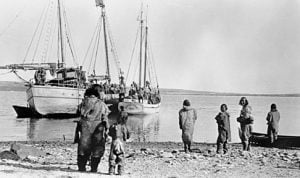
People & Culture
On thin ice: Who “owns” the Arctic?
As the climate heats up, so do talks over land ownership in the Arctic. What does Canadian Arctic Sovereignty look like as the ice melts?
- 4353 words
- 18 minutes
This article is over 5 years old and may contain outdated information.
History

In 1913, 16 years before The Royal Canadian Geographical Society (RCGS) came into existence with the mandate “to make Canada better known to Canadians and to the world,” three men at the heart of a historic expedition into the western Arctic were setting out to do exactly that.

And though it’s hard to say whether the Society’s founding members might have had Vilhjalmur Stefansson, Rudolph Anderson and Diamond Jenness in mind when setting down that directive, the three members of the first Canadian Arctic Expedition (CAE), whose 100th anniversary is this year, are certainly appropriate inspirations. After all, from 1913 to 1918 they discovered and mapped new territory, performed the first comprehensive survey of flora and fauna in the Canadian Arctic and conducted an authoritative ethnographical study on the then little-known Copper Inuit. Their work in the fields of geography, zoology and anthropology during the expedition was significant and groundbreaking enough to see all three men named to the Society’s College of Fellows.
Stefansson, who led the expedition’s Northern Party, played a key role in filling in the blanks that existed on the map of Canada’s Arctic at the time, helping discover four new islands in the western Arctic. His team also conducted soundings of the ocean floor and performed the first tidal observations in the region. Shortly after becoming a member of the RCGS in 1930, Stefansson donated a selection of his published works on the social and cultural geography of the Arctic to the Society and became a full-fledged Fellow.

Anderson, an American mammalogist and zoologist, was in charge of the Southern Party. And though he would go on to write and publish his own work after his team finished in 1916, he spent much of his career editing the 16-volume series of the expedition’s scientific volumes, Report of the Canadian Arctic Expedition 1913-18. For this and his other contributions to Canadian zoology, Anderson became a Fellow in the early years of the Society.
Jenness’ anthropological work on the Copper Inuit, conducted as a member of the Southern Party, yielded numerous works including two books still popular today, The People of the Twilight and Dawn in Arctic Alaska. Jenness was elected an RCGS Fellow in 1962, the same year he received the Society’s Massey Medal, which recognizes outstanding career achievement in the exploration, development or description of the geography of Canada.
Stefansson, Anderson and Jenness were lauded for their work during the latter’s acceptance of the medal. “It is to such men — and to The Royal Canadian Geographical Society that does so much to encourage them and to interest us — that we owe a great debt,” said Major General H.A. Young, the RCGS president at the time. “No people can aspire to greatness without a knowledge of their land, an appreciation of their past and a vision of their future.”
For more stories about the CAE, see “Canada’s unsung expedition”.
Are you passionate about Canadian geography?
You can support Canadian Geographic in 3 ways:

People & Culture
As the climate heats up, so do talks over land ownership in the Arctic. What does Canadian Arctic Sovereignty look like as the ice melts?

Exploration
A century after the start of the thrilling expedition that strengthened claims to Canadian sovereignty in the Arctic, the first Canadian Arctic Expedition remains a largely unknown part of the country’s history

History
This year's search is about much more than underwater archaeology. The Victoria Strait Expedition will contribute to northern science and communities.

Environment
The uncertainty and change that's currently disrupting the region dominated the annual meeting's agenda